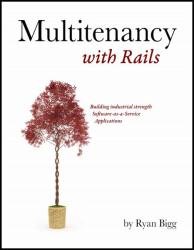Multitenancy with Rails: And subscriptions too!
- Добавил: literator
- Дата: 21-12-2021, 21:26
- Комментариев: 0
 Название: Multitenancy with Rails: And subscriptions too!
Название: Multitenancy with Rails: And subscriptions too!Автор: Ryan Bigg
Издательство: Leanpub
Год: 2015-06-29
Страниц: 204
Язык: английский
Формат: pdf, mobi, epub
Размер: 10.1 MB
This book will teach you super neat tricks about Ruby, Rails and PostgreSQL while you build a multi-tenanted, Software as a Service, Ruby on Rails application.
During the writing of Rails 4 in Action (previously Rails 3 in Action), I wrote an engine called Forem which provides forum functionality for Rails applications in the form of a drop-in engine. The work on the Forem engine serves not only as a basis for the Getting Started with Engines Rails Guide, but also this book. I can’t put it any simpler than this: the book you’re reading right now uses the Forem engine and a couple of other goodies to build a multi-tenanted forum application. It sounds hard (hint: it is), but with this book’s guidance you should learn to avoid the pitfalls that many other developers have encountered. Where Rails 3 in Action is more of a “you know Ruby, now let’s learn Rails” book, this book is directed at people who have at least some Rails experience and feel comfortable building Rails applications. As such, core concepts of Rails aren’t explained as we go along in this book. While there may be some unfamiliar concepts in this book, the explanation that comes with them should make you familiar with them in no time. This book is neither for beginners or experts, but something in between. I thought I would mention that because people have been confused about it before.
This book is a book that will teach you about building a multi-tenant Ruby on Rails application. Hopefully you knew that already. This particular kind of application is usually referred to as a “Software as a Service” (or SaaS for short) application, as it’s a piece of software which is providing a service to a group of people. The application we’ll be building in this book isn’t based off an original, outlandish idea, but a rather simple one: hosted blogs. This is a similar idea to Tumblr, or other blogging platforms. For a user to be able to create their own posts, they can sign up to our application for an account (Chapter 2), which would be sandboxed from the other accounts on the system (Chapter 3). Once they’re done with that, they will then be able to create posts for their blog (Chapter 4). In the later chapters, we cover things such as monthly subscriptions and billing for them (Chapter 5). That’s a quick overview of what you’ll be learning in this book as a whole. At the end of it, you will know how you can build a multi-tenanted Software as a Service Rails application. Woah, buzzwords! Let’s explain what is meant here.
Multitenancy:
A single-tenant application is an application that is used by a single entity, be it a single user or a single company. It’s not important in this case that the data in this application be kept separate from the other data since all the data belongs to one entity. A multi-tenancy application is one that can be used by multiple entities at the same time, typically with the data for those entities kept separate from the other entities. When a user signs in, they should only be able to see one set of data, and not the data from other places.
Скачать Multitenancy with Rails
Внимание
Уважаемый посетитель, Вы зашли на сайт как незарегистрированный пользователь.
Мы рекомендуем Вам зарегистрироваться либо войти на сайт под своим именем.
Уважаемый посетитель, Вы зашли на сайт как незарегистрированный пользователь.
Мы рекомендуем Вам зарегистрироваться либо войти на сайт под своим именем.
Информация
Посетители, находящиеся в группе Гости, не могут оставлять комментарии к данной публикации.
Посетители, находящиеся в группе Гости, не могут оставлять комментарии к данной публикации.
